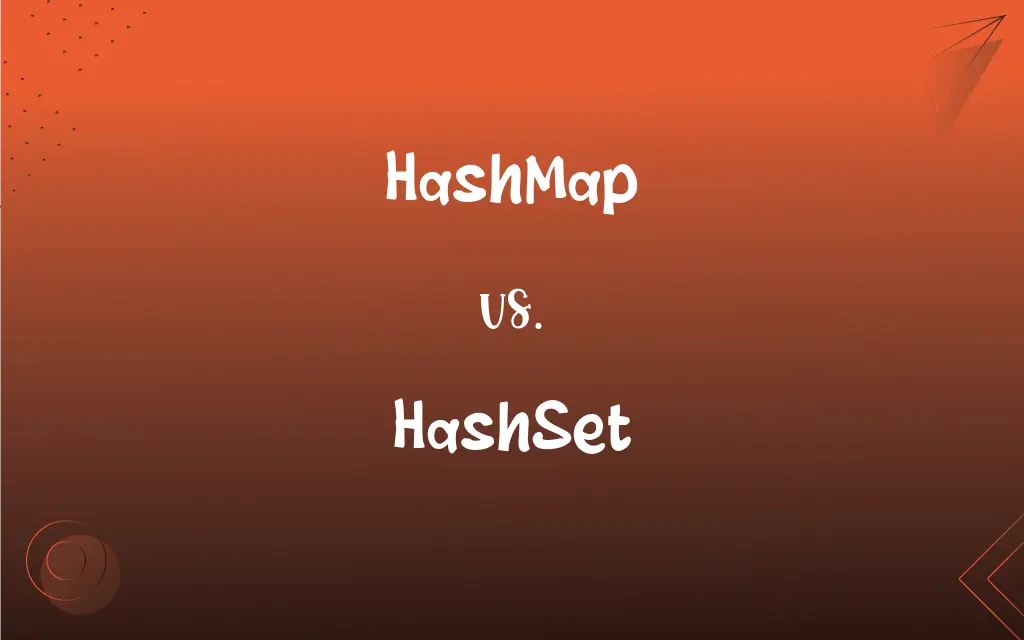HashMap vs. HashSet: What's the Difference?
Edited by Harlon Moss || By Janet White || Published on March 17, 2024
HashMap stores key-value pairs for efficient data retrieval, while HashSet stores unique elements without duplicates, both using a hash table mechanism.

Key Differences
HashMap in programming is a data structure that stores elements in key-value pairs, making data retrieval efficient through hashing. HashSet, on the other hand, is a collection that stores unique elements and doesn't allow duplicates, also using hashing for storage.
In a HashMap, each key maps to a specific value, allowing for quick searches, updates, and retrieval using the key. In contrast, a HashSet simply stores objects and is mainly used to test for the presence of a particular item, as it doesn't associate values with keys.
HashMaps are ideal for scenarios where quick access to data based on unique identifiers is needed. HashSets, however, are more suited for situations where the uniqueness of data elements is a priority, as they ensure no two identical objects are stored.
The performance of a HashMap is measured by how efficiently it can insert, delete, and locate key-value pairs. For a HashSet, performance is about the ability to quickly add, remove, and check if an object exists without duplicates in the set.
HashMap allows one null key and multiple null values, reflecting its capacity to store a variety of objects. HashSet, while also able to store null values, is distinct in that it only allows a single instance of null since it focuses on uniqueness.
ADVERTISEMENT
Comparison Chart
Data Structure Type
Stores key-value pairs
Stores unique elements
Purpose
Efficient data retrieval using keys
Ensures uniqueness of elements
Duplication
Keys are unique, values can be duplicated
No duplicate elements allowed
Usage Scenario
When key-based data access is needed
When storing a set of unique items
Null Values
One null key, multiple null values allowed
Only one null element allowed
ADVERTISEMENT
HashMap and HashSet Definitions
HashMap
HashMap is a data structure that maps keys to values.
I used a HashMap to store employee IDs and their names.
HashSet
HashSet implements the Set interface in Java.
For my project, I used HashSet to store distinct tags.
HashMap
It allows fast retrieval of data based on unique keys.
Retrieving the price of a product using its code is efficient with HashMap.
HashSet
It ensures no duplicate elements are stored.
HashSet is perfect for creating a list of unique words in a document.
HashMap
In a HashMap, each key is unique.
In my HashMap, each student's name is linked to their unique ID.
HashSet
HashSet is backed by a hash table for storage.
Storing usernames in a HashSet prevents duplicates.
HashMap
HashMap implements the Map interface in Java.
I implemented a word frequency counter using HashMap.
HashSet
HashSet is a collection that stores unique elements.
I used a HashSet to keep track of unique visitor IDs on a website.
HashMap
HashMaps can contain one null key and multiple null values.
I stored some optional data in a HashMap with null values.
HashSet
HashSet allows only one null element.
I added a null entry to my HashSet of optional features.
HashMap
Alternative spelling of hash map
FAQs
How does HashMap handle duplicates?
It allows duplicate values but not duplicate keys.
What is a HashMap?
A data structure for storing key-value pairs.
Is HashMap ordered?
No, it doesn't maintain any order of its elements.
What interfaces do HashMap and HashSet implement in Java?
HashMap implements Map, and HashSet implements Set.
What hash function do HashMap and HashSet use?
They use the hashCode() method of the objects.
What is a HashSet?
A collection that stores a set of unique elements.
Is HashSet synchronized?
Like HashMap, HashSet is also not synchronized.
How do you iterate over a HashMap?
Using methods like keySet(), entrySet(), or values().
Can HashSet store duplicate items?
No, it ensures all elements are unique.
Can HashSet contain null values?
Yes, but only one null element.
Can null be a key in HashMap?
Yes, HashMap allows one null key.
Can a HashMap contain a HashSet?
Yes, it can store any object, including HashSet.
Does HashSet maintain an insertion order?
Generally, no, but LinkedHashSet does.
Are HashMaps synchronized?
No, they are not thread-safe by default.
How do you iterate over a HashSet?
Using an Iterator or enhanced for loop.
Is it faster to search in a HashMap or HashSet?
Both offer fast lookups, but it depends on the operation.
When should you use HashMap over HashSet?
Use HashMap when you need to retrieve data via keys.
How do HashMap and HashSet handle collisions?
They use mechanisms like chaining or rehashing.
What's the initial capacity of a HashMap in Java?
By default, it's 16.
Does HashSet have a default capacity?
Yes, its initial capacity is typically 16.
About Author
Written by
Janet WhiteJanet White has been an esteemed writer and blogger for Difference Wiki. Holding a Master's degree in Science and Medical Journalism from the prestigious Boston University, she has consistently demonstrated her expertise and passion for her field. When she's not immersed in her work, Janet relishes her time exercising, delving into a good book, and cherishing moments with friends and family.
Edited by
Harlon MossHarlon is a seasoned quality moderator and accomplished content writer for Difference Wiki. An alumnus of the prestigious University of California, he earned his degree in Computer Science. Leveraging his academic background, Harlon brings a meticulous and informed perspective to his work, ensuring content accuracy and excellence.
































































